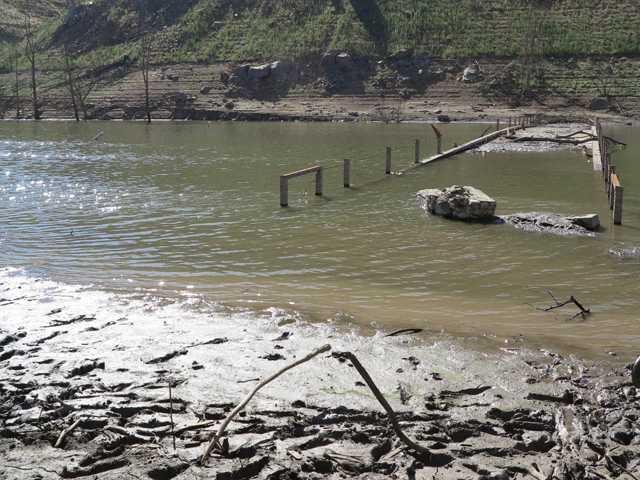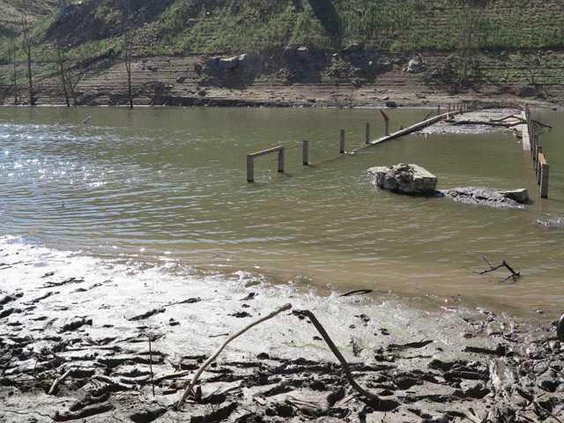Dry lawns in Manteca and Lathrop along with farmers are helping prevent an ecological disaster on the Stanislaus River.
That’s because cutbacks in water use within the South San Joaquin Irrigation District along with Oakdale Irrigation District has helped make water available for critical releases that will start Aug. 28 from Tulloch Lake to cool down water in the Stanislaus River.
Those living near Tulloch Lake are being notified today of the pending releases. Such notification is required anytime the lake drops more than 10 feet.
Shallow flows in the Stanislaus due to the drought are raising water temperatures to a point they will soon create lethal conditions for the endangered Chinook salmon and other fish.
Water is available to help fish thanks in part to farmers cutting back 25 percent over last year’s use through aggressive conservation practices without sacrificing crops as well as the cities of Manteca, Lathrop, and Tracy cutting back the surface water they use by 20 percent.
It also helped that May rain and snow now means 248,000 acre feet of water is predicted to remain in New Melones on Sept. 30 as opposed to the previously projected 150,000 acre feet in the reservoir that holds 2.4 million acre feet of water.
Playing a role as well was the standoff the SSJID and OID made in April when they refused to comply with a Bureau of Reclamation order to increase flows out of Tulloch that is located below the Bureau’s New Melones Reservoir to accommodate fish. The two districts refused to comply because the Bureau couldn’t prove the water that was to be released was theirs and not what legally belonged to the SSJID and OID.
At one point federal attorneys sent a letter threatening to jail SSJID General Manager Jeff Shields for defying a federal order and violating provisions of the Endangered Species Act.
The SSJID stood firm as did OID.
SSJID has vested interest
in keeping fish alive
“The last people who want to see fish die on the Stanislaus River is the SSJID,” Shields told Manteca Rotarians on Thursday during their meeting at Ernie’s. “That would assure federal takeover of the river.”
The SSJID and OID are well versed — some argue better than the state and federal agencies overseeing New Melones and the Stanislaus River — in fish conditions on the river. That’s because they have spent over $1 million during the past 12 years hiring biologists to study and track fish movements as well as identify what imperils fish and what helps them thrive along the Stanislaus River.
At the time they also argued holding water back would be critical to lowering temperatures in the late summer and fall when fish are most imperiled by river conditions.
The two districts and the government agencies came to an understanding about what water would be used and also avoided lowering Tulloch Lake — a strategy crafted as a defensive move by SSJID and OID to protect their stored water for farmers and the three cities.
The timing this month for increased water releases at Tulloch couldn’t be better in terms of conserving water. That’s because every five years the SSJID is required by the Federal Energy Regulatory Commission to lower Tulloch Lake significantly so that gates can be tested to make sure they operate properly in the event they need to be opened for flood control purposes. It’s been more than four years since the last time such a test took place.
Tulloch will be at half
capacity until at least
March after test is done
Tulloch, which is at 64,000 acre feet or 2,000 acre feet less than its maximum capacity, will be lowered to about half its capacity or 36,000 acre feet in the coming weeks. It will stay at that level through at least March.
In the past when such tests have been conducted and the elevation was taken down from 510 to 480 feet, the lake was raised to near capacity within weeks. That won’t happen this time around due to the severe drought.
The water is released from the bottom of the reservoir which means it is the coolest available. The water will be replaced after the certification is done by increased Melones Reservoir releases. Currently New Melones is at 333,800 acre feet. Once storage drops below 300,000 acre feet water will be tapped from the bottom of the reservoir as power generation will cease.
On Aug. 23, the Bureau will start releasing water from the bottom of Melones.
Shields noted New Melones is currently releasing 2,000 acre feet a day heading into the two biggest months for water demand — August and September.
The reservoir is falling at rate of six inches a day.
“We (SSJID) have an obligation to work with other agencies but stand firm when we have to,” Shields said.
Youre helping save river
Conservation critical for fish; Tulloch dropping in half





